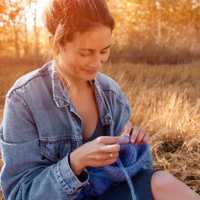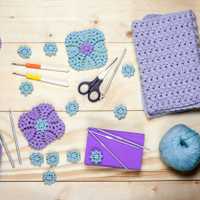Knitting Stitches: 5 Most Popular Knitting Stitch Types
By Alice Seidel
Knitting Stitches: 5 Most Popular Knitting Stitch Types
By Alice Seidel
Welcome to the wonderful world of knitting! Even if you've been here for a while, there is always something new about this most fascinating craft!
Let me start by introducing you to the five stitch types that I believe are at the very heart of knitting!
Learning to knit, you know, is nothing more than learning different knitting stitch types.
Wherever I roam on the Web, many of the same questions arise. Over and over again, I come across forums and discussions with the same types of concerns.
In this article, I will attempt to explain some of the basic knitting stitches and everything they encompass.
I will talk about 'the knit stitch', 'the purl stitch', 'knit 2 together', 'yarn-over', and the 'stockinette stitch'.
These five stitches, I believe, form the very foundation of knitting. Learn, and perfect, each one of these, and you will be well on your way to becoming an expert in knitting!
All other patterns emerge from these few stitches. So, let's begin!
'The Knit Stitch'. Have you ever looked at something knitted? I mean, really looked? If you have, you will see one side of the knitting looks different from the other.
Knitting follows structures. The knit stitch is formed by making loops which interweave with one another; one after another.
The knit stitch will resemble little "v" patterns when viewed from the knit side of a pattern.
To form a "knit stitch" you use one needle to pull a loop of yarn through the existing stitch on the other needle. (You can knit with more than two needles, but that's a discussion for another day.)
Holding both needles in your hands, insert the right needle, from "front to back" into the first stitch on the left needle. Keeping the yarn at the back, bring it "over" the tip of the needle, counterclockwise. Pull the yarn down, and catch it with the right needle.
Slip the "old" stitch off the left needle and you have a new stitch on the right needle! A knit stitch!
Many times you will be told the knit stitch is the "right side" or RS of your work. But, once in a while, it will be the "wrong side" or WS.
Either way, it's good to know those two abbreviations.
'The Purl Stitch'. The purl stitch will resemble what looks like "brick-face" when viewed from the purl side of a pattern.
Unlike the knit stitch, with the purl stitch, you hold the yarn to the "front" of your knitting.
Insert the right needle from "back to front" into the first stitch on the left needle. With your right index finger, wrap yarn counterclockwise around and down the right needle.
Draw the right needle and yarn backwards through the "old" stitch. Slip off the old stitch. A new stitch forms. A purl stitch!
'Knit 2 Together.' Now, this is easy! Just knit two together! Insert the right needle into the second stitch from the tip of the left needle, making sure to "catch" the first stitch with it.
Bring your yarn over and up, then down, catch your yarn, slip the old stitches off, and you have a new stitch in their place.
You will have only one new stitch from two. Knitting two together is often used to decrease stitches or to create an open-work pattern.
'Yarn-over'. Adding a yarn-over, or YO, is also used when creating open-work designs. To do a yarn-over after a knit stitch, just bring your yarn across your work from the back to the front. Then, knit the next stitch.
You will see an extra "stitch" on the row. When you come to that stitch in your next row of knitting, it will not look anchored like the others. That's because you put it there, all of itself.
Knit it like you would knit any stitch. As you go, you will see that yarn-overs create "holes" or openwork designs in your knitting.
'Stockinette Stitch'. This stitch is knitting's most common. All it consists of is knitting one row, then purling the next, and so on, and so on.
The stockinette stitch is exactly where every knitter should begin. And stick with it until you know your stitches well!
So there you have it! 5 most popular knitting stitch types!
Get knitting!
Copyright 2006 Alice Seidel
Keep YOUR knitting on the "Cutting Edge" with FREE patterns. The place where smart knitters gather resources and share stories. FREE Details ==>http://www.theknitstitch.com
Article Source: http://EzineArticles.com/?expert=Alice_Seidel
Welcome to the wonderful world of knitting! Even if you've been here for a while, there is always something new about this most fascinating craft!
Let me start by introducing you to the five stitch types that I believe are at the very heart of knitting!
Learning to knit, you know, is nothing more than learning different knitting stitch types.
Wherever I roam on the Web, many of the same questions arise. Over and over again, I come across forums and discussions with the same types of concerns.
In this article, I will attempt to explain some of the basic knitting stitches and everything they encompass.
I will talk about 'the knit stitch', 'the purl stitch', 'knit 2 together', 'yarn-over', and the 'stockinette stitch'.
These five stitches, I believe, form the very foundation of knitting. Learn, and perfect, each one of these, and you will be well on your way to becoming an expert in knitting!
All other patterns emerge from these few stitches. So, let's begin!
'The Knit Stitch'. Have you ever looked at something knitted? I mean, really looked? If you have, you will see one side of the knitting looks different from the other.
Knitting follows structures. The knit stitch is formed by making loops which interweave with one another; one after another.
The knit stitch will resemble little "v" patterns when viewed from the knit side of a pattern.
To form a "knit stitch" you use one needle to pull a loop of yarn through the existing stitch on the other needle. (You can knit with more than two needles, but that's a discussion for another day.)
Holding both needles in your hands, insert the right needle, from "front to back" into the first stitch on the left needle. Keeping the yarn at the back, bring it "over" the tip of the needle, counterclockwise. Pull the yarn down, and catch it with the right needle.
Slip the "old" stitch off the left needle and you have a new stitch on the right needle! A knit stitch!
Many times you will be told the knit stitch is the "right side" or RS of your work. But, once in a while, it will be the "wrong side" or WS.
Either way, it's good to know those two abbreviations.
'The Purl Stitch'. The purl stitch will resemble what looks like "brick-face" when viewed from the purl side of a pattern.
Unlike the knit stitch, with the purl stitch, you hold the yarn to the "front" of your knitting.
Insert the right needle from "back to front" into the first stitch on the left needle. With your right index finger, wrap yarn counterclockwise around and down the right needle.
Draw the right needle and yarn backwards through the "old" stitch. Slip off the old stitch. A new stitch forms. A purl stitch!
'Knit 2 Together.' Now, this is easy! Just knit two together! Insert the right needle into the second stitch from the tip of the left needle, making sure to "catch" the first stitch with it.
Bring your yarn over and up, then down, catch your yarn, slip the old stitches off, and you have a new stitch in their place.
You will have only one new stitch from two. Knitting two together is often used to decrease stitches or to create an open-work pattern.
'Yarn-over'. Adding a yarn-over, or YO, is also used when creating open-work designs. To do a yarn-over after a knit stitch, just bring your yarn across your work from the back to the front. Then, knit the next stitch.
You will see an extra "stitch" on the row. When you come to that stitch in your next row of knitting, it will not look anchored like the others. That's because you put it there, all of itself.
Knit it like you would knit any stitch. As you go, you will see that yarn-overs create "holes" or openwork designs in your knitting.
'Stockinette Stitch'. This stitch is knitting's most common. All it consists of is knitting one row, then purling the next, and so on, and so on.
The stockinette stitch is exactly where every knitter should begin. And stick with it until you know your stitches well!
So there you have it! 5 most popular knitting stitch types!
Get knitting!
Copyright 2006 Alice Seidel
Keep YOUR knitting on the "Cutting Edge" with FREE patterns. The place where smart knitters gather resources and share stories. FREE Details ==>http://www.theknitstitch.com
Article Source: http://EzineArticles.com/?expert=Alice_Seidel



